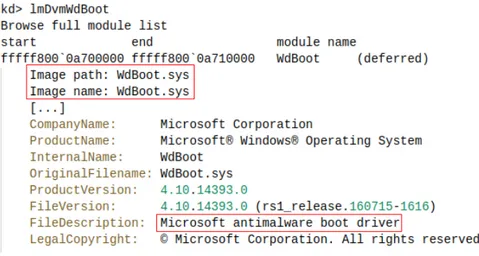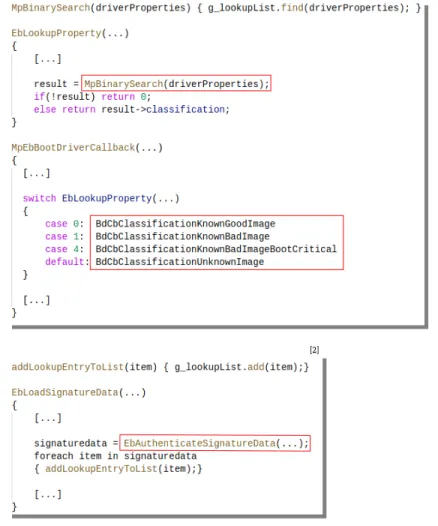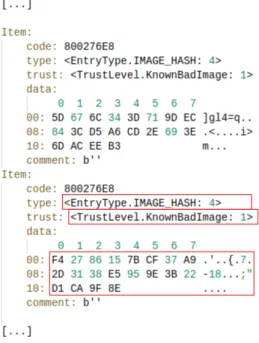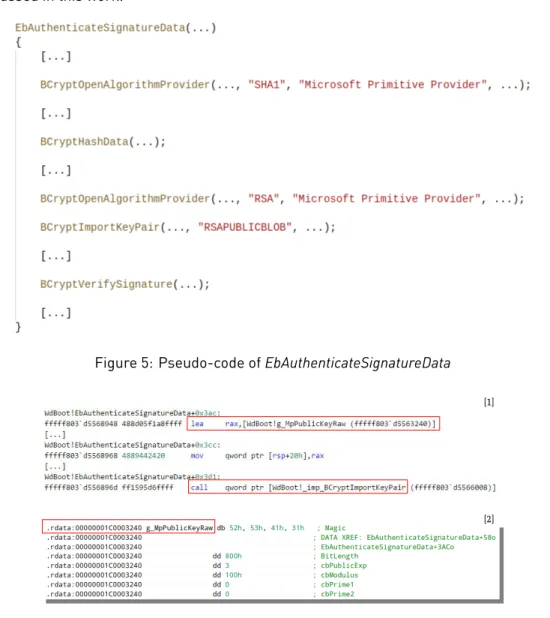HAL Id: hal-03088315
https://hal.archives-ouvertes.fr/hal-03088315
Submitted on 26 Dec 2020
HAL is a multi-disciplinary open access
archive for the deposit and dissemination of
sci-entific research documents, whether they are
pub-lished or not. The documents may come from
teaching and research institutions in France or
abroad, or from public or private research centers.
L’archive ouverte pluridisciplinaire HAL, est
destinée au dépôt et à la diffusion de documents
scientifiques de niveau recherche, publiés ou non,
émanant des établissements d’enseignement et de
recherche français ou étrangers, des laboratoires
publics ou privés.
Distributed under a Creative Commons Attribution - NonCommercial - NoDerivatives| 4.0
ELAM: The Windows Defender ELAM Driver
Aleksandar Milenkoski
To cite this version:
Aleksandar Milenkoski. ELAM: The Windows Defender ELAM Driver. [Technical Report] ERNW
Enno Rey Netzwerke GmbH. 2019. �hal-03088315�
ELAM: The Windows Defender ELAM Driver
Aleksandar Milenkoski)
amilenkoski@ernw.de
This work is part of the Windows Insight series. This series aims to assist efforts on analysing inner working principles, functionalities, and properties of the Microsoft Windows operating system. For general inquiries contact Aleksandar Milenkoski (amilenkoski@ernw.de) or Dominik Phillips (dphillips@ernw.de). For inquiries on this work contact the corresponding author ()).
The content of this work has been created in the course of the project named ’Studie zu Systemaufbau, Protokollierung, Härtung und Sicherheitsfunktionen in Windows 10 (SiSyPHuS Win10)’ (ger.) - ’Study of system design, logging, hard-ening, and security functions in Windows 10’ (eng.). This project has been contracted by the German Federal Office for Information Security (ger., Bundesamt für Sicherheit in der Informationstechnik - BSI).
Required Reading
In addition to referenced work, related work focussing on the Trusted Platform Module (TPM), part of the
Win-dows Insight series, are relevant for understanding concepts and terms mentioned in this document.
Technology Domain
The operating system in focus is Windows 10, build 1607, 64-bit, long-term servicing branch (LTSB).
1 Introduction
In this work, we discuss the early launch anti-malware (ELAM) technology implemented in Windows 10. This technology, implemented in a driver referred to as the ELAM driver, is used for checking drivers for malware and is part of the booting process of Windows 10. Therefore, it is critical for the security of the boot process of the system. We provide an overview of the decision-making process of the ELAM driver for categorizing an executable as benign or malicious. We also provide an overview of the structure of the malware database that this driver uses, and of the verification of the integrity of this database.
The ELAM driver is initialized before the majority of the other drivers and is used for checking for malware the drivers loaded after it. An ELAM driver implements anti-malware technology, for example, detection of known malicious driver images based on searching a database of properties of such images (e.g., image hashes). This is the ELAM database of malware signatures.
Any vendor may develop an ELAM driver following the development guidelines provided by Microsoft.1 The
1https://docs.microsoft.com/en-us/windows-hardware/drivers/install/elam-driver-requirements [Retrieved: 22/9/2017]
amilenkoski.client.ernw.net 2019-05-21 11:51:06
Windows 10 system is distributed with an ELAM driver that is part of the Microsoft’s Windows Defender anti-malware technology.2
2 The Windows Defender ELAM Driver
The Windows Defender ELAM driver is implemented in the %SystemRoot%\System32\drivers\WdBoot.sys exe-cutable. It is loaded by the Windows loader and initialized in the kernel. It is unloaded by the kernel when it has checked for malware all boot drivers. Figure 1 depicts the information on the Windows Defender ELAM Driver that the kernel maintains after loading it.
Figure 1: Information on the Windows Defender ELAM driver
The ELAM driver performs anti-malware verification in its function MpEbBootDriverCallback. This is a callback function invoked when the kernel notifies the ELAM driver that a driver image is to be initialized. The kernel no-tifies the ELAM driver that it initializes a driver image that needs to be verified. The notification is implemented in the PnpNotifyEarlyLaunchImageLoad kernel function.
Figure 2 depicts a pseudo-code of the implementation of MpEbBootDriverCallback and relevant functions that it invokes ([1] in Figure 2). MpEbBootDriverCallback invokes EbLookupProperty, which sets an integer code indi-cating the category of the verified image. Adopting the Microsoft terminology on this topic, an image may be categorized as:
• a known good image (code value BdCbClassificationKnownGoodImage in Figure 2); • a known bad image (code value BdCbClassificationKnownBadImage in Figure 2);
• a known bad image of a boot-critical driver (code value BdCbClassificationKnownBadImageBootCritical in Figure 2); or
• an unknown image (code value BdCbClassificationKnownBadImage in Figure 2).
We refer to these categories as ELAM image categories. MpEbBootDriverCallback passes the integer set by
EbLookupProperty back to the kernel.Based on the image categorization done by the ELAM driver, the kernel
decides whether the image of a given boot driver will be initialized in the PnpDoPolicyCheck kernel function. The kernel brings a decision based on the configuration of the ELAM group policy located at the policy path:
Computer Configuration -> Administrative Templates -> System -> Early Launch Antimalware. For example, users
https://docs.microsoft.com/en-us/windows/threat-protection/windows-defender-antivirus/windows-defender-antivirus-in-windows-may configure this policy such that only known good images are initialized.3 If the ELAM group policy allows for
it, the boot driver is initialized.
[1]
[2]
Figure 2: Pseudo-code of MpEbBootDriverCallback and functions that it invokes
EbLookupProperty performs a binary search for specific properties of the verified driver image, for example, file
hash values, in the ELAM database of malware signatures (MpBinarySearch, driverProperties in Figure 2). Each entry of this database is stored in an array (g_lookupList in Figure 2). This array is filled when the signature database is loaded into the driver’s memory space.
The loading of the ELAM signature database is done when the driver is initialized and is performed in two steps ([2] in Figure 2): First, the function MpEbLoadSignatures (not depicted in Figure 2) using the ZwOpenKey routine4
loads the signature database. This database is stored in the form of a registry hive in the system’s registry. Then, the function EbLoadSignatureData verifies the integrity of the signature database by invoking
EbAuthen-ticateSignatureData. It also stores each entry of the database (item in Figure 2) in the previously mentioned
array of database entries (g_lookupList, addLookupEntryToList in Figure 2). The stored entries are later used in
EbLookupProperty.
Figure 3 depicts this database loading operation. The ELAM signature database is loaded in the registry as the registry hive HKEY_LOCAL_MACHINE\ELAM (\REGISTRY\MACHINE\ELAM in Figure 3). We observed that this registry hive is unloaded when the ELAM driver is unloaded. The registry hive of the ELAM signature database
3https://blogs.technet.microsoft.com/dubaisec/2016/05/09/elam-driver/ [Retrieved: 22/9/2017]
is stored on the file-system at %SystemRoot%\System32\Config\elam (see Figure 3). This enabled us to analyze the contents of the registry hive after the ELAM driver and its signature database have been unloaded.
Figure 3: The ELAM signature database in the registry
The ELAM signature database is stored as binary data. This data has a specific format structuring it into multiple entries. Each entry, among other things, consists of a malware signature, an entry type, and a trust level. A malware signature is often, but not necessarily, a hash value. An entry type is a code value indicating the type of data representing a malware signature. A trust level is a code value corresponding to the ELAM image categories known good image, known bad image, known bad image of a boot-critical driver, and unknown image. The trust level specifies the ELAM category of image associated with the malware signature.
We observed the above by parsing the signature database of the Windows Defender ELAM driver using a parser we developed. The code of this parser, implemented in the Python programming language, is placed in the Ap-pendix, section ’ELAM Database Parser‘. Figure 4 depicts the output of the parser, where EntryType, TrustLevel, and data mark an entry type, a trust level, and a malware signature, respectively. An example entry in the ELAM signature database is the hash value F4 27 86 [...] 9F 8E, which is a hash value of a known bad image.
Figure 4: The ELAM signature database
As we previously mentioned, the integrity of the ELAM signature database is verified in
unautho-function verifies the signature of the ELAM signature database using the kernel implementation of the Crypto-graphic API: Next Generation (CNG) library. The ELAM signature database may be updated by system services, such as Windows Update. These services mount and modify the registry hive HKEY_LOCAL_MACHINE\ELAM. However, the updated signature database has to be properly signed since its integrity is verified by the ELAM driver as discussed in this work.5
Figure 5: Pseudo-code of EbAuthenticateSignatureData
[1]
[2]
Figure 6: The public key used for verification of the Windows Defender ELAM signature database
EbAuthenticateSignatureData first hashes the signature database (BcryptHashData6in Figure 5) using the Secure
Hash Algorithm (SHA)-1 algorithm and the software-implemented Microsoft Primitive Provider
(BcryptOpenAl-gorithmProvider in Figure 5). It then imports a public key (BCryptImportKeyPair, RSAPUBLICBLOB7in Figure 5).
Finally, EbAuthenticateSignatureData uses the Microsoft Primitive Provider and the imported public key to decrypt the signature of the ELAM signature database and compare it with the previously calculated hash value of this database (BCryptVerifySignature8in Figure 5).
5https://docs.microsoft.com/en-us/windows-hardware/drivers/install/elam-driver-requirements [Retrieved: 22/9/2017]
6https://msdn.microsoft.com/en-us/library/windows/desktop/aa375468(v=vs.85).aspx [Retrieved: 22/9/2017]
7https://msdn.microsoft.com/en-us/library/windows/desktop/aa375472(v=vs.85).aspx [Retrieved: 22/9/2017]
We observed that EbAuthenticateSignatureData imports a public key hardcoded in the WdBoot.sys driver exe-cutable, stored in the variable g_MpPublicKeyRaw. This indicates that the root of trust for verifying the mal-ware signature database used by the Windows ELAM driver is the driver itself. Figure 6 depicts the passing of g_MpPublicKeyRaw to BcryptImportKeyPair for importing ([1] in Figure 6). It also depicts the declaration of
g_MpPublicKeyRaw in the WdBoot.sys driver executable, which we observed with the IDA disassembler ([2] in
Figure 6).
According to the Microsoft’s ELAM driver development guidelines, vendors of ELAM drivers may store the ELAM signature database and related relevant data in the registry keys Measured, Policy, and/or Config, under the registry hive HKEY_LOCAL_MACHINE\ELAM. We observed that the Windows Defender ELAM driver stores its database in Measured.
Appendix
ELAM Database Parser
This script can also be found in the folder files of the Windows Insight file repository, under the name
elam_-defender_parser.py.
import argparse import s t r u c t
from c o l l e c t i o n s import namedtuple import enum
from Crypto . Pu bli cK ey import RSA from Crypto . Cipher import PKCS1_v1_5
from Crypto . U t i l . number import b y t e s _ t o _ l o n g , l o n g _ t o _ b y t e s
from h e l p e r l i b import p r i n t _ h e x I I , print_hexdump , hexdump
c l a s s Item ( namedtuple ( ’ Item ’ , [ ’ type ’ , ’ t r u s t _ c o d e ’ , ’ data ’ , ’ comment ’ ] ) ) : d e f __ st r__ ( s e l f ) :
l = [ ’DB e n t r y : ’ ,
f ’ \ tTy pe : { s e l f . t y p e ! r } ’ ,
f ’ \ tImage c a t e g o r y : { s e l f . t r u s t _ c o d e ! r } ’ ,
f ’ \ t D a t a : \ n \ t ’ + ’ \ n \ t ’ . j o i n ( hexdump ( s e l f . data , header = True ) ) , f ’ \ tComment : { s e l f . comment } ’ ,
]
r e t u r n ’ \ n ’ . j o i n ( l )
c l a s s EntryType ( enum . IntEnum ) : THUMBPRINT_HASH = 1 CERTIFICATE_PUBLISHER = 1 ISSUER_NAME = 1 IMAGE_HASH = 4 VERSION_INFO = 7 c l a s s T r u s t L e v e l ( enum . IntEnum ) : KnownGoodImage = 0 KnownBadImage = 1 UnknownImage_2 = 2 UnknownImage = 3 KnownBadImageBootCritical = 4 PUBLIC_EXPONENT = 0 x010001
MODULUS = i n t . from_bytes ( s t r u c t . pack ( ” 2 5 6B” , *[
0xb3 , 0x95 , 0xde , 0x5b , 0 xc2 , 0xe1 , 0x89 , 0 xf7 , 0x56 , 0 xc2 , 0x20 , 0 xbf , 0x27 , 0xd2 , 0x88 , 0x1a , 0x0a , 0xac , 0xdb , 0 xc7 , 0x19 , 0x36 , 0x7b , 0xce , 0x37 , 0x83 , 0xd1 , 0xec , 0x42 , 0xd3 , 0xab , 0x30 , 0x54 , 0xa5 , 0x51 , 0x11 , 0xd8 , 0 xcc , 0xec , 0x80 , 0xab , 0x89 , 0x5a , 0xae , 0x18 , 0x71 , 0x11 , 0 x7c , 0x85 , 0x1a , 0x1a , 0x53 , 0x54 , 0x46 , 0x3e , 0x55 , 0 x5c , 0x43 , 0x5d , 0x4b , 0 x9f , 0 xc7 , 0x54 , 0x57 , 0x75 , 0 xc5 , 0x02 , 0xe2 , 0x63 , 0xa9 , 0x94 , 0x56 , 0xa7 , 0x3b , 0xe0 , 0 xc3 , 0xed , 0 x5f , 0x66 , 0x9d , 0x60 , 0x78 , 0x1e , 0xac , 0x92 , 0x3d , 0x48 , 0xe9 , 0x51 , 0x5d , 0x79 , 0x2a , 0x22 , 0x9a , 0x9e , 0xd3 , 0xbc , 0x15 , 0xbe , 0x7a , 0x4e , 0x97 , 0xe8 , 0 x1f , 0 x9c , 0x80 , 0 xf5 , 0 xfb , 0x94 , 0x0b , 0 x5f , 0xb7 , 0 x6f , 0x0d , 0x57 , 0xa0 , 0x09 , 0x55 , 0x68 , 0x78 , 0 xf3 , 0x5d , 0x7b , 0x9a , 0x9b , 0x08 , 0xa3 , 0xa6 , 0x41 , 0x18 , 0 xf0 , 0x17 , 0x11 , 0x89 , 0x9b , 0x71 , 0x73 , 0x27 , 0xa2 , 0x55 , 0x51 , 0 xc0 , 0xee , 0xa5 , 0x70 , 0 x6f , 0xb8 , 0x40 , 0x2a , 0x85 , 0xe9 , 0x91 , 0x20 , 0x4b , 0 x0c , 0xd2 , 0x29 , 0xa2 , 0x01 , 0x36 , 0x96 , 0 x1c , 0xbb , 0xd5 , 0 xef , 0x95 , 0x68 , 0x43 , 0 xfb , 0x77 , 0x42 , 0x88 , 0x1a , 0xae , 0x60 , 0x14 , 0 xfe , 0x0b , 0x0d , 0xd3 , 0x28 , 0x04 , 0x98 , 0x15 , 0x71 , 0x3e , 0xba , 0xb3 , 0x80 , 0x65 , 0x6d , 0x2b , 0 x7f , 0x30 , 0xca , 0 xf2 , 0 x6c , 0xa6 , 0x47 , 0xd3 , 0 x3c , 0x57 , 0x50 , 0x0d , 0xb3 , 0xbb , 0xed , 0x6d , 0x75 , 0 xf2 , 0 x0f , 0x26 , 0x29 , 0 xf7 , 0 xc6 , 0xe4 , 0x20 , 0x5e , 0 xaf , 0x87 , 0 xf1 , 0x8b , 0x8e , 0x57 , 0x99 , 0x00 , 0 xf3 , 0x84 , 0xe5 , 0x25 , 0x10 , 0x05 , 0 x2c , 0xeb , 0x77 , 0xa3 , 0xdb , 0xbd , 0x7e , 0xd4 , 0xb5 , 0x60 , 0xb6 , 0x6a , 0xa0 , 0x99 , 0x25 , 0x59 , 0 x2f , 0x10 , 0x69 , 0 xf4 , 0x62 , 0xe1 , 0 x8c , 0 x2b ] ) , ’ big ’ ) MODULUS = i n t . from_bytes ( b y t e s . fromhex ( ’ b395de5bc2e189f756c220bf27d2881a0aacdbc719367bce3783d1ec42d3ab3054a55111d8ccec80ab895aae1871117c851a1a5354463e555c435d4b9fc7545775c502e263 a99456a73be0c3ed5f669d60781eac923d48e9515d792a229a9ed3bc15be7a4e97e81f9c80f5fb940b5fb76f0d57a009556878f35d7b9a9b08a3a64118f01711899b717327a25551c0eea5706 fb8402a85e991204b0cd229a20136961cbbd5ef956843fb7742881aae6014fe0b0dd328049815713ebab380656d2b7f30caf26ca647d33c57500db3bbed6d75f20f2629f7c6e4205eaf87f18b 8 e579900f384e52510052ceb77a3dbbd7ed4b560b66aa09925592f1069f462e18c2b ’ ) , ’ big ’ )
PUBLIC_KEY = RSA . c o n s t r u c t ( ( MODULUS, PUBLIC_EXPONENT ) )
d e f parse ( f p ) : tag = f p . read ( 1 ) [ 0 ]
s i z e = s t r u c t . unpack ( ’ < I ’ , f p . read ( 3 ) + b ’ \ 0 ’ ) [ 0 ] r e t u r n tag , f p . read ( s i z e )
d e f main ( argv =None ) :
parser = argparse . ArgumentParser ( )
parser . add_argument ( ’ Database ’ , t y p e = argparse . F i l e T y p e ( ’ rb ’ ) )
args = parser . parse_args ( args = argv ) f p = args . Database
w h i l e True : t r y :
tag , data = parse ( f p )
i f t ag == 0xA9 : a s s e r t l e n ( data ) >= 4
o f f s e t = s t r u c t . unpack_from ( ’ < I ’ , data ) [ 0 ] + 4 a s s e r t o f f s e t < l e n ( data )
some_type = s t r u c t . unpack_from ( ’ <B ’ , data [ o f f s e t : ] ) [ 0 ] i f some_type == 9 :
data_type , t r u s t _ c o d e = s t r u c t . unpack_from ( ’ <BB’ , data [ 4 : ] ) e n t r y _ d a t a = data [ 6 : o f f s e t ]
item = Item ( EntryType ( d a t a _ t y p e ) , T r u s t L e v e l ( t r u s t _ c o d e ) , e n t r y _ d a t a , data [ o f f s e t + 2 : ] )
p r i n t ( s t r ( item ) )
e l i f tag == 0xAC :
p r i n t ( ” Encrypted s i g n a t u r e : ” )
print_hexdump ( data , c o l o r e d =True , header = True )
s i g n a t u r e = PUBLIC_KEY . e n c r y p t ( b y t e s ( reversed ( data ) ) , None ) [ 0 ] p r i n t ( ” \ n ” ) ;
p r i n t ( ” Decrypted s i g n a t u r e ( DER ) : ” )
print_hexdump ( s i g n a t u r e , c o l o r e d =True , header =True , f o l d e d = True ) p r i n t ( ” \ n ” ) ; s i g n a t u r e = s i g n a t u r e . s p l i t ( b ’ \ x00 ’ , 1 ) [ 1 ] t r y : a s s e r t s i g n a t u r e [ 0 ] == 0 x30 l = s i g n a t u r e [ 1 ] s i g n a t u r e = s i g n a t u r e [ 2 : 2 + l ] a s s e r t s i g n a t u r e [ 0 ] == 0 x30 l = s i g n a t u r e [ 1 ] a l g o = s i g n a t u r e [ 2 : 2 + l ] hashsum = s i g n a t u r e [ 2 + l : ] a s s e r t hashsum [ 0 ] == 0 x4 l = hashsum [ 1 ] hashsum = hashsum [ 2 : l + 2 ] p r i n t ( ” Hash : ” , hashsum . hex ( ) ) p r i n t ( ” \ n ” ) ; except : pass e l i f t a g == 0x5C : c o n t i n u e ; e l i f t a g == 0x5D : c o n t i n u e ; e l s e :
r a i s e V a l u e E r r o r ( ” Parsing e r r o r . Unknown t ag { : 0 2 x } ” . format ( ta g ) ) except I n d e x E r r o r :
break
i f __name__ == ’ __main__ ’ : main ( )



